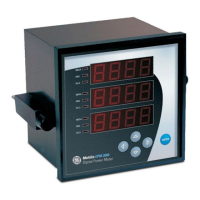
Do you have a question about the GE Multilin EPM 2000 Series and is the answer not in the manual?
| Category | Power Meter |
|---|---|
| Mounting | Panel mount |
| Storage Temperature | -40°C to +85°C |
| Frequency Range | 45 to 65 Hz |
| Communication Interfaces | RS485 (Modbus RTU), Ethernet (Modbus TCP) |
| Voltage Inputs | 3-phase, 4-wire |
| Display | LCD |
| Power Measurement | Active power, reactive power, apparent power, power factor |
| Humidity | 5% to 95% non-condensing |
| Current Inputs | 3 |
| Operating Temperature | -20°C to +60°C |
Details the physical characteristics of the EPM 2000, including its front and rear panels.
Describes the EPM 2000's front panel layout, indicators, and keypad operations.
Provides detailed technical specifications, features, measurements, and accuracy of the EPM 2000.
Explains how to navigate and operate the EPM 2000 using its keypad controls.
Guides users through the process of setting up and configuring the EPM 2000.
Provides step-by-step instructions for editing and changing the EPM 2000's setup values.
Explains the Energy Integrator function and its parameters like Run Hrs, On Hrs, and Interruptions.
Explains the fundamentals of three-phase systems, including Delta and Wye configurations.
Discusses energy consumption (WH) and the impact of poor Power Factor.
Details the advanced '3D' kVA measurement capability and its setup options.
Covers the procedures for installing the EPM 2000, including panel mounting.
Provides instructions on selecting a location and mounting the EPM 2000 in a panel.
Discusses considerations for choosing the optimal location for the EPM 2000.
Details the panel mounting process, including cut-out dimensions and clamp usage.
Explains the requirements and connections for the EPM 2000's auxiliary power supply.
Discusses the need, selection, and planning for PTs and CTs for meter connections.
Details how to connect voltage signals, including PT connections and fuse selection.
Explains how to connect current signals, including terminal identification and polarity.
Explains the importance of CT polarity and how to check for correct connections.
Guides on configuring the system type (Star/Wye or Delta) for the EPM 2000.
Details the RS-485 communication protocol, baud rates, and network setup.
Provides information on Modbus RTU communication and SCADA software configuration.
Details the register map for accessing EPM 2000 data via Modbus.
